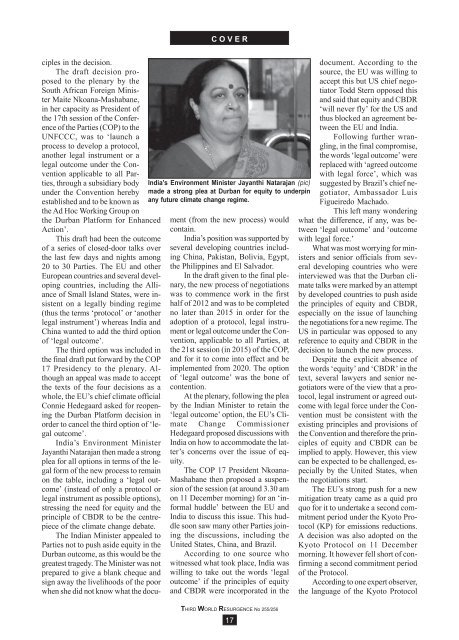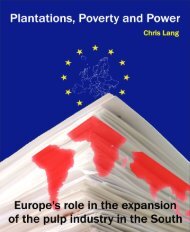C O V E RIndia’s Environment Minister Jayanthi Natarajan (pic)made a strong plea at Durban for equity to underpinany future climate change regime.ciples in the decision.The draft decision proposedto the plenary by theSouth African Foreign MinisterMaite Nkoana-Mashabane,in her capacity as President ofthe 17th session of the Conferenceof the Parties (COP) to theUNFCCC, was to ‘launch aprocess to develop a protocol,another legal instrument or alegal outcome under the Conventionapplicable to all Parties,through a subsidiary bodyunder the Convention herebyestablished and to be known asthe Ad Hoc Working Group onthe Durban Platform for EnhancedAction’.This draft had been the outcomeof a series of closed-door talks overthe last few days and nights among20 to 30 Parties. The EU and otherEuropean countries and several developingcountries, including the Allianceof Small Island States, were insistenton a legally binding regime(thus the terms ‘protocol’ or ‘anotherlegal instrument’) whereas India andChina wanted to add the third optionof ‘legal outcome’.The third option was included inthe final draft put forward by the COP17 Presidency to the plenary. Althoughan appeal was made to acceptthe texts of the four decisions as awhole, the EU’s chief climate officialConnie Hedegaard asked for reopeningthe Durban Platform decision inorder to cancel the third option of ‘legaloutcome’.India’s Environment MinisterJayanthi Natarajan then made a strongplea for all options in terms of the legalform of the new process to remainon the table, including a ‘legal outcome’(instead of only a protocol orlegal instrument as possible options),stressing the need for equity and theprinciple of CBDR to be the centrepieceof the climate change debate.The Indian Minister appealed toParties not to push aside equity in theDurban outcome, as this would be thegreatest tragedy. The Minister was notprepared to give a blank cheque andsign away the livelihoods of the poorwhen she did not know what the document(from the new process) wouldcontain.India’s position was supported byseveral developing countries includingChina, Pakistan, Bolivia, Egypt,the Philippines and El Salvador.In the draft given to the final plenary,the new process of negotiationswas to commence work in the firsthalf of 2012 and was to be completedno later than 2015 in order for theadoption of a protocol, legal instrumentor legal outcome under the Convention,applicable to all Parties, atthe 21st session (in 2015) of the COP,and for it to come into effect and beimplemented from 2020. The optionof ‘legal outcome’ was the bone ofcontention.At the plenary, following the pleaby the Indian Minister to retain the‘legal outcome’ option, the EU’s ClimateChange CommissionerHedegaard proposed discussions withIndia on how to accommodate the latter’sconcerns over the issue of equity.The COP 17 President Nkoana-Mashabane then proposed a suspensionof the session (at around 3.30 amon 11 December morning) for an ‘informalhuddle’ between the EU andIndia to discuss this issue. This huddlesoon saw many other Parties joiningthe discussions, including theUnited States, China, and Brazil.According to one source whowitnessed what took place, India waswilling to take out the words ‘legaloutcome’ if the principles of equityand CBDR were incorporated in thedocument. According to thesource, the EU was willing toaccept this but US chief negotiatorTodd Stern opposed thisand said that equity and CBDR‘will never fly’ for the US andthus blocked an agreement betweenthe EU and India.Following further wrangling,in the final compromise,the words ‘legal outcome’ werereplaced with ‘agreed outcomewith legal force’, which wassuggested by Brazil’s chief negotiator,Ambassador LuisFigueiredo Machado.This left many wonderingwhat the difference, if any, was between‘legal outcome’ and ‘outcomewith legal force.’What was most worrying for ministersand senior officials from severaldeveloping countries who wereinterviewed was that the Durban climatetalks were marked by an attemptby developed countries to push asidethe principles of equity and CBDR,especially on the issue of launchingthe negotiations for a new regime. TheUS in particular was opposed to anyreference to equity and CBDR in thedecision to launch the new process.Despite the explicit absence ofthe words ‘equity’ and ‘CBDR’ in thetext, several lawyers and senior negotiatorswere of the view that a protocol,legal instrument or agreed outcomewith legal force under the Conventionmust be consistent with theexisting principles and provisions ofthe Convention and therefore the principlesof equity and CBDR can beimplied to apply. However, this viewcan be expected to be challenged, especiallyby the United States, whenthe negotiations start.The EU’s strong push for a newmitigation treaty came as a quid proquo for it to undertake a second commitmentperiod under the Kyoto Protocol(KP) for emissions reductions.A decision was also adopted on theKyoto Protocol on 11 Decembermorning. It however fell short of confirminga second commitment periodof the Protocol.According to one expert observer,the language of the Kyoto ProtocolTHIRD WORLD RESURGENCE No 255/25617
C O V E Rdecision was only of the nature of‘taking note’ of the ‘intention’ of Partiesto convert targets to real commitments‘with a view’ to adopting themat the next climate conference in December2012. It thus remains to beseen if the commitments will be made,and, if so, what the numbers and substancewill be.In return, developed countriessucceeded in securing a new processof climate talks on mitigation effortsby all Parties, without explicit referenceto equity and CBDR.Heated exchangeThe often heated exchange on theDurban Platform took place at a jointinformal meeting of COP 17 and the7th session of the Conference of theParties serving as the meeting of theParties to the Kyoto Protocol (CMP)which was convened by COP/CMPPresident Nkoana-Mashabane late on10 December, following the closingsessions of the AWGKP andAWGLCA.Nkoana-Mashabane outlined theelements of what she called the ‘Durbanpackage’, which were (i) the secondcommitment period (2CP) foremissions reductions by Annex I Partiesunder the KP; (ii) a decision onthe work of the AWGLCA; (iii) a decisionon the Green Climate Fund(GCF); and (iv) an agreement on theDurban Platform for enhanced action.Nkoana-Mashabane asked Partiesto adopt each of the decisionswithout further debate and amendmentswhen they were presented duringthe formal sessions of the COPand the CMP respectively, saying thatParties required ‘assurances fromeach other to agree to all the draft decisions’,clearly suggesting a ‘take-itor-leave-it’approach. She said thatthis was needed to ‘make history andstrengthen multilateralism’.Several delegations expressedfrustration that their concerns werenot heard when they were first raisedduring the closing sessions of theAWGKP and the AWGLCA prior tothe joint informal meeting of the COPand CMP.Hedegaard said the EU had a‘Equity has to be thecentrepiece’The following is the text of remarks byIndian Minister for Environment andForests Jayanthi Natarajan at aclosed-door ministerial session at theDurban conference on 10 December,following strong statements by severaldeveloped-country ministers and aparticularly accusatory one by CanadianEnvironment Minister Peter Kent.The Indian Minister’s remarks met withapplause in the room.I DO not know how to start. I haveheard people across the room carefully.I am from India and I represent1.2 billion people. My country has atiny per capita carbon footprint of 1.7ton and our per capita GDP is evenlower.I was astonished and disturbed bythe comments of my colleague fromCanada who was pointing at us as towhy we are against the roadmap. I amdisturbed to find that a legally bindingprotocol to the Convention, negotiatedjust 14 years ago, is now being junkedin a cavalier manner. Countries whichhad signed and ratified it are walkingaway without even a polite goodbye.And yet, pointing at others.I was also deeply moved listeningto the comments of my colleaguesand friends from the small islandstates. Our positions may be different,but their sentiments resonate with mevery strongly. India has 600 islandswhich may be submerged, we havedeltaic region in which millions of peoplelive. We are absolutely at the forefrontof the vulnerability of climatechange. When I talk here, I have infront of my eyes, the face of the lastIndian who is affected by the effects ofclimate change.It would be helpful if we do not talkat each other and do not prejudge eachother.As a developing country, the principlesof equity and CBDR are centralfor us. India is asking for space for basicdevelopment for its people and povertyeradication. Is this an unreasonabledemand? Former Prime Ministerof India Indira Gandhi said that povertyis the greatest polluter and developmentis the greatest healer. Equityhas to be the centrepiece of the climatediscussion and our negotiationsshould be built on it. We cannot acceptthe principle of CBDR to be diluted.The firewall of CBDR must notbe broken. Equity in the debate mustbe secured.I too raise my voice for urgency.Climate change is the most pressingand urgent problem for us. I too havea grandson, the son of my son. Climatechange affects us too. What isimportant is what action we are takingto address it. We are not saying nothingshould be done now, or no actionshould be taken. On the contrary. Weare asking that the actions of the developed-countryParties must be reviewed.We have taken ambitious stepsin India to address climate change. MyPrime Minister has announced thatour per capita emissions would neverexceed that of developed countries.Has any other country done this? Wehave ambitious energy efficiency targets.We have pledged to lower theemissions intensity of our GDP by 20-25% by 2020. A recent report from theStockholm Institute has noted that themitigation pledges of developing countriesamount to more mitigation thanthat of developed countries.What we demand is for existingcommitments to be met. What we demandis comparability of actions. Wedemand that the emissions gap mustbe bridged.Coming to the text you have presented,Madam Chair, I have threecomments.First of all, there is an imbalancein the two texts. The KP is weak. Itdoes not have:• The numbers for KP Parties, nottill next years• A timeline for ratification• An indication of how the gap inthe implementation will be avoided.My biggest concern with referenceto the texts is that there is noreference to the fundamental principleof equity and CBDR in the biggerpicture text.We should have clear timelinesthat advance the actions and ambitionof Parties. We in the developing worldare taking very ambitious domesticactions. It is because we need urgentactions that we should urgently implementthe Bali Action Plan andoperationalise the Cancun Agreements.We should have an ambitious implementationphase till 2013 and thengo to the Review in 2013-15 to makean assessment based on science andcommitments.We should then begin work on thearrangements that can enhance ourambition further. We should not confuselegally binding arrangements withambition. We need commitments, notmere hollow promises. ÿÿÿÿÿÿÿuTHIRD WORLD RESURGENCE No 255/25618















